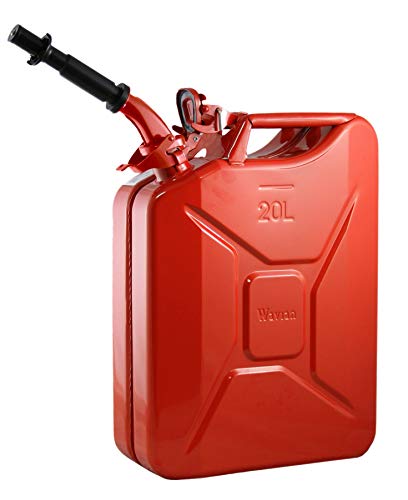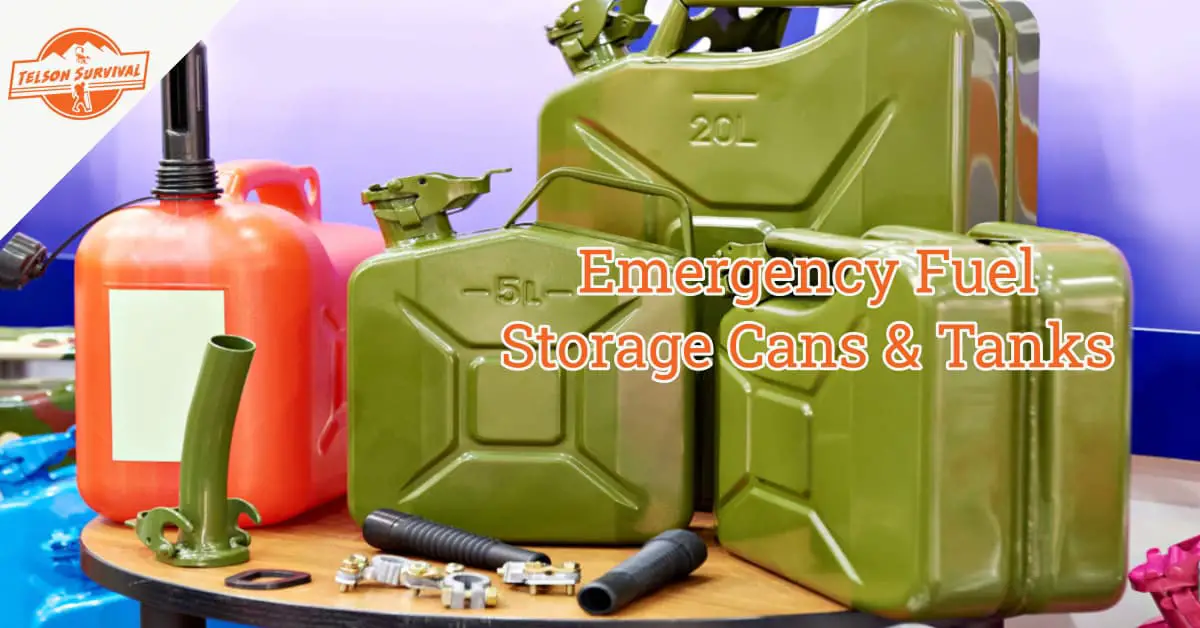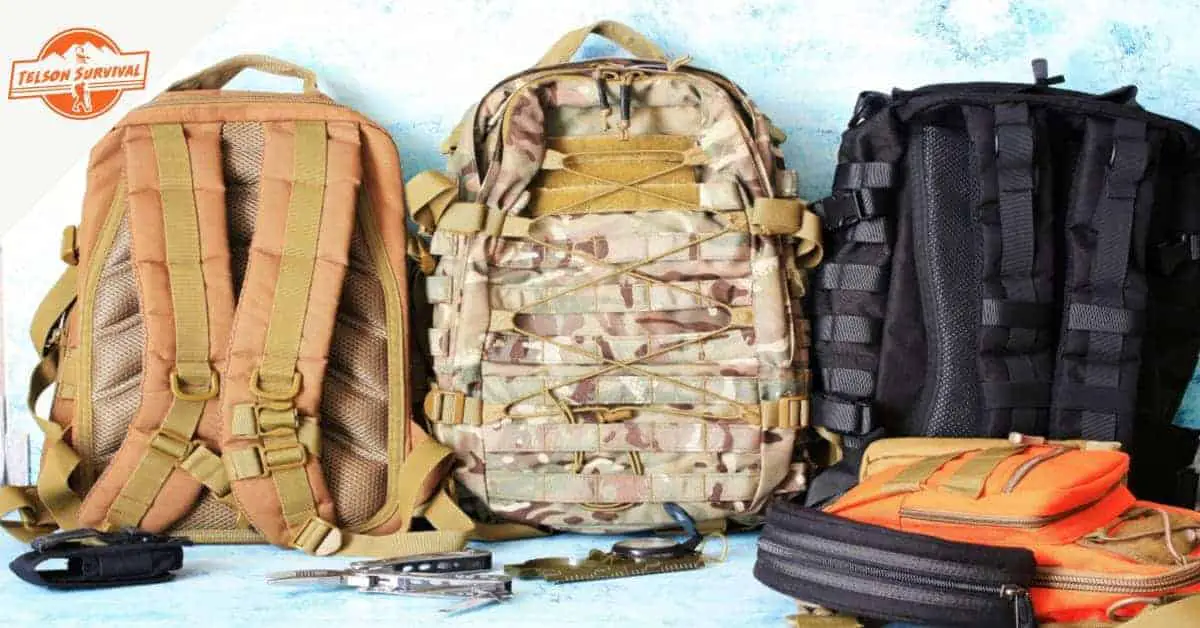Have you been in the dark during an emergency? If you have, you know that it is not the most pleasant situation to be in. If you haven’t, don’t create the condition for it to happen: store fuel!
Fuel storage is a core part of prepping for emergencies. If SHTF, you want to have enough fuel to heat and light your home, cook your food, and charge essential appliances and devices.
But being able to use stored fuel comes with the commitment to store it right and in the best fuel storage containers. So what are the best fuel storage containers and tanks for emergency preparedness?
The best fuel storage containers for emergency preparedness are those fitted with a non-spill spout and have safety features like anti-flame devices. They are made in compliance with fuel storage and handling regulating agencies like EPA and CARB and have the standard fuel storage cans color codes.
Because fossil fuels have a limited shelf life, knowing how and where to store them for the long term is extremely important.
This article considers the storage of common petroleum fuels (gasoline, diesel, and kerosene). These are the main fuels you’ll need to purchase from a fuel station while other gas fuels are usually packaged by the manufacturer.
Specifically, we’ll tell you about:
- Basic Info about Prepper Fuel Storage Containers.
- Best Fuel Storage Containers for Emergency Preparedness (Gasoline, Diesel, and Kerosene).
- Buying Tips for Fuel Storage Containers.
- Underground and Aboveground Fuel Storage Tanks
- Prepper Fuel Storage FAQs
In a hurry? If you just want to get to our conclusions, here are our top picks and recommendations!
| Preview |
Product |
Price |
|

|
No-Spill 1450 5-Gallon Poly Gas Can (CARB Compliant),Red
|
$46.89
$41.99 |
Buy On Amazon |

|
Scepter Portable Gas Fuel Tank, Container Caddy Can w/ Siphon Pump, 14 Gallon, Red
|
$154.59
$134.29 |
Buy On Amazon |

|
Justrite 5 Gallon Type II Red Safety Gas Can for Gasoline with Flame Arrester, Self-Closing Lid, and...
|
|
Buy On Amazon |

|
Wavian USA Authentic NATO Jerry Can and Spout System - Rust-Proof, EPA & CARB Compliant, Red, 20...
|
$97.49 |
Buy On Amazon |

|
Eagle 5 Gallon Type I Yellow Safety Gas Can for Diesel with Flame Arrester and Self-Closing Lid,...
|
$78.94 |
Buy On Amazon |

|
No-Spill 1456 5-Gallon Poly Kerosene Can (CARB & EPA Approved) , Blue
|
$45.92
$35.95 |
Buy On Amazon |

|
Scepter FR1K501 SmartControl Kerosene Can, 5 Gallon, Blue, 11.5 x 9.9 x 16.75
|
$48.06 |
Buy On Amazon |
Last update on 2025-01-17 / Affiliate Links / Images from Amazon Product Advertising API
Prepper Fuel Storage Containers: The Basics
Not every container you find in home and hardware stores or online marketplaces is good for fuel storage. We’ll tell you more about that at length later.
Before then, we give you some basic info that is a ‘must know’ when it comes to fuel storage tanks and cans.
- When storing fuel, 15-20 gallons are the recommended amount to fuel a vehicle or fill a generator during an emergency.
- Storage cans for common fuels have standard colors. If you can’t go by these color codes when storing fuel, label your fuel cans clearly:
- Red – Gasoline
- Blue – Kerosene
- Yellow – Diesel
- Green – Oil
- Typical fuel can size can range from 1, 2.5, to 5 gallons. Larger fuel storage tanks can be 55 gallons or more.
- Fuel storage cans are usually made of metal or plastic. Metal is always a better option when it comes to long term fuel storage.
- Metal cans are of two types: Type I and Type II. Type I metal cans dispense fuel from the same filling point while Type II fuel cans have a vent spout for easy dispensing that is different from the filling vent.
- Plastic fuel cans degrade over time and can leak into fuel and absorb it. Metal fuel cans can rust too, but they will generally last longer than plastic.
- Fuel storage cans should be stored in a well-ventilated shed/garage outside and away from the home as they are potential fire ignition points.
- Always check with your local regulations about the type, size, and other specifications on the allowed fuel storage cans.
- Fuel storage containers and cans can vary in size depending on how much fuel you want to store.
- Small-size jerry cans that you can easily carry with your hand.
- Semi-portable containers amounting to a few jerry cans.
- Custom-made vehicle fuel containers.
- Large tanks installed underground or above ground on your property.
With these basics, we can now proceed to give you our best selection of fuel storage cans and tanks.
Best Fuel Storage Containers for Emergency Preparedness
A can or tank for your fuel storage will depend on how much fuel you want to store and the laid down standards in your local area.
Regardless, some containers can generally be considered the best quality for long term fuel storage. Here are our picks for the best fuel cans categorized according to container material, size, and fuel type.
Best Gasoline Storage Containers
Stored gasoline stays fresh for 6-12 months if stored in the recommended containers and environment. The standard red gasoline storage containers can be plastic or metal.
Here are our 4 best picks for gasoline storage tanks:
Best small-size plastic gasoline storage container: No-Spill 1450 5-Gallon Poly Gas Can
The No-Spill Poly Gas Can is a 5-gallon gasoline container whose greatest feature is in its name; ‘no-spill’. It is made to be durable, safely store fuel, and dispense it without spilling using the no-spill spout.
Best features of the No-Spill Poly Gas Can:
- A funnel-spout with an auto-shut feature that prevents gas from dripping.
- A dust cover to keep the dispensing spout clean.
- A stainless steel mesh that’s included in the spout to prevent gas contamination and prevent accidental ignition.
- A thumb button that controls gas dispensing.
- EPA and CARB compliant.
Last update on 2025-01-17 / Affiliate Links / Images from Amazon Product Advertising API
Potential drawbacks of the No-Spill Poly Gas Can:
- The thumb button may prove tricky to handle at first.
- The can may leak if not put on a flat surface or if filled to the brim.
Best large-size plastic gasoline storage container: DuraMax 14-Gallon Rolling Gas Can
The DuraMax gasoline tank is mounted on wheels, which makes it ideal for preppers looking for the best container for long term gasoline storage that they can easily move when they need to. A 14-gallon gasoline tank is also a good size for a prepper gas storage option.
Best features of the DuraMax 14-Gallon Rolling Gas Can:
- Made of high-density Polypropelyne plastic and has enhanced resistance to disintegration and denting.
- The can is wheeled for easy transportation.
- Has an ergonomic tough handle for safety when moving it.
- Designed to keep the gasoline tank off the ground, thus increasing stability and ventilation.
- Has a MaxFlo siphon pump included for easy gas-dispensing and allows safety auto-shutoff.
- Includes a 10ft hose with shut-off valves at the tank and the dispensing end.
Last update on 2025-01-17 / Affiliate Links / Images from Amazon Product Advertising API
Potential drawbacks of the DuraMax 14-Gallon Rolling Gas Can:
- Customer reviews suggest that wheeling the gasoline tank can be cumbersome because the hard plastic wheels are tight and hard to spin.
- May be cumbersome when transported by hand.
Best small-size metal gasoline storage container: Justrite Type II AccuFlow Safety Can
This 5-gallon gasoline storage can is constructed with a 100% steel body and finished with high-quality powdered paint in the standard red color for gasoline cans.
The Justrite Type II AccuFlow Safety Can will resist any solvents, rusting, and tough handling. The can is great for long-term gasoline storage and an optimal choice for a prepper’s seasonal tools.
Best features of the Justrite AccuFlow Safety Can:
- Color-coded to avoid mixing fuels.
- Has a stainless steel flame arrester to prevent flashback ignition.
- Has a safe-squeeze trigger for smooth non-spill pouring.
- Has an ergonomic lift-lever for controlled filling.
- Has a 9ʺ hose with a narrow opening for controlled pouring.
- Meets NFPA and OSHA requirements.
Last update on 2025-01-17 / Affiliate Links / Images from Amazon Product Advertising API
Potential drawbacks of the Justrite AccuFlow Safety Can:
- Hard to refill at a gas station.
- Lacks a funnel point for filling smaller fuel tank openings.
Best gasoline storage jerry can: Wavian USA Jerry Fuel Can and Spout System
The Wavian USA fuel jerry can is made of rust-proof military-grade steel that is manufactured to comply with several quality standards in Europe and America including CARB, DOT, EPA, and UN-Dangerous goods approval. The 20-litter jerry can be purchased in standard fuel color codes, including the red for gasoline.
Best features of the Wavian USA fuel jerry can:
- Comes with a spout and a spout adapter for cars or appliances with a smaller filling vent. You simply turn the spout clockwise to fit any opening then push it to start filling.
- Fully paint-coated both on the outside with epoxy-polyester powder coat and on the inside with fuel and rust-resistant Rezol enamel.
- Has an internal breather pipe for non-spill pouring.
- Has a leak-proof Bayonet-style closure and quick release nozzle.
- Has a strengthened hinge on the cap to avoid bending when closing and a locking pin on the cap.
Last update on 2025-01-18 / Affiliate Links / Images from Amazon Product Advertising API
Potential drawbacks of the Wavian USA fuel jerry can:
- Can be complicated to handle and pour at the beginning.
Best Diesel Storage Containers
Stored diesel will stay fresh longer than gasoline (18-24 months). But good storage in recommended containers is just as important for both fuels. The color code for diesel tanks is yellow, and as with gasoline, they can be plastic or metal.
Here are our 2 best picks for diesel storage tanks:
Best plastic diesel storage container: Surecan Self Venting Diesel Fuel Can
If you want a diesel can that’s both durable and innovative, then the Surecan is no doubt what you are looking for.
The 5 gallon Surecan (19L) can allows you to simply direct the nozzle where you want the gas and you can fill without needing to tip the can. Surecan is designed to be dependable for long term fuel storage.
Best features of the Surecan Self Venting Diesel Fuel Can:
- A patented non-spill rotating nozzle and thumb-release trigger that dispenses diesel from the bottom of the can by gravity without needing a funnel.
- The can is self-ventilating.
- Durable design with a sturdy and comfortable grip handle.
- Made of CARB certified material.
No products found.
Potential drawbacks of the Surecan Self Venting Diesel Fuel Can:
- Complicated to operate in the beginning.
- Quite pricey compared to other 5-gallon plastic models.
Best metal diesel storage container: Eagle UI-50-SY Type I Metal Diesel Safety Can
Type I fuel cans have a single opening for both filling and pouring fuel, but they are great for long term storage. Such is the Eagle type I metal diesel can. You can use it to safely store or transport diesel.
Best features of the Eagle Type I Metal Diesel Can:
- Made of rust-proof galvanized steel.
- Powder coated for greater resistance to wear.
- Has a flame arrestor to prevent ignition.
- The spout cap opens automatically to vent internal vapors and closes to preempt spills and leaks.
- Safety warning label in 3 languages included
- Compliant with OSHA standards for safe storage and handling of flammables.
Last update on 2025-01-17 / Affiliate Links / Images from Amazon Product Advertising API
Potential drawbacks of the Eagle type I metal diesel can:
- You’ll need to use a funnel to avoid spilling when pouring the diesel.
Best Kerosene Storage Containers
Preppers can store kerosene for a number of uses:
- Burning in lamps.
- Burning in heaters, cookers, and furnaces.
- As a solvent in oils.
Compared to gasoline and diesel, kerosene has a longer shelf life (5 years) but good storage in recommended containers is still crucial.
Here are our 2 best picks for kerosene storage tanks:
Best overall kerosene storage container: No-Spill 1456 Poly Kerosene Can
Another of the No-Spill products that’s an optimal choice for kerosene storage. The 5-gallon No-Spill kerosene can is made for long term storage and equipped with several efficiency features for neat fuel pouring.
Best features of the No-Spill Poly Kerosene Can:
- A user-controlled funnel spout that eliminates the need for horizontal tilting and the consequent fuel spill.
- Easy to operate with a thumb button that’s pressed to initiate pouring and released to stop.
- Has a dust cover to keep the spout clear of dust.
- An integrated stainless steel mesh to prevent gas contamination and prevent accidental ignition.
- The auto stop nozzle is removable to allow filling from the same opening that serves for pouring.
- Has a rear handle that creates balance for easy pouring.
- Compliant with CARB and EPA standards for safe fuel storage and handling.
Last update on 2025-01-17 / Affiliate Links / Images from Amazon Product Advertising API
Potential drawbacks of the No-Spill Poly Kerosene Can:
- The thumb button can be tricky to control at first.
Best non-spill kerosene storage can: Scepter Kerosene Jerry CAN
The Scepter Kerosene Jerry Can is one of the best when it comes to a clean fuel refill, thanks to its unique nozzle. The 5-gallon kerosene storage container allows for controlled pouring depending on how fast or slow you want the fuel to fill.
Best features of the Scepter Kerosene Jerry CAN:
- A trigger button that starts oil flow and controls its speed depending on how much you squeeze.
- No-spill controlled kerosene flow rate.
- An integrated air vent in the spout.
- Equipped with child safety and an integrated flame mitigation device at the opening
- EPA and CARB compliant.
- Made of sturdy plastic with an added layer for durability and protection.
Last update on 2025-01-17 / Affiliate Links / Images from Amazon Product Advertising API
Potential drawbacks of the Scepter Kerosene Jerry CAN:
- The thumb button can be tricky to control at first.
As you can tell, these fuel storage cans hold between 5-14 gallons of fuel. But what if you want to store more fuel? Can you go for larger fuel tanks?
Underground And Aboveground Fuel Storage Tanks
If you are looking to store large amounts of fuel, you might want to go for an underground or aboveground fuel storage tank.
If you do, you’ll need to abide by both underground and aboveground fuel tank requirements regarding quantity, tank quality, length of storage time, and other safety guidelines. You can read details about using bulk storage containers in our long term fuel storage methods article.
Nonetheless, here are a few guidelines you might want to bear in mind.
- Fuel tanks should be stored away from your home, from pilot lights, and any ignition sources.
- Storing large amounts of fuel is guided by local fire and safety guidelines. Most codes will restrict fuel storage in residential places to 25 gallons. So be sure that you can store the amount you desire before going for it.
- Fuel tanks have labels declaring adherence to safety codes and to show danger warnings. Ensure you go by these requirements.
- When installing fuel storage tanks, do so in an isolated shed at a shady location where there is no direct sunlight or accessibility by children.
Unlike smaller fuel storage containers that you can simply order and purchase from online stores or other retail home and hardware stores, you will need to contact underground and aboveground fuel storage tanks experts to make an order according to your needs. See as an example the fuel storage tank options by envirosafe.
You might also want to compare the strengths and drawbacks of underground and aboveground fuel storage tanks before you make a purchasing decision. Here’s what you should know.
Aboveground vs underground fuel storage tank costs
Installing underground fuel tanks will cost you more as it includes some excavation work and specialized equipment. This cost also factors in time.
If maintenance is needed, it will cost you more to make repairs on an underground tank than an aboveground one. More time is also required to repair an underground fuel storage tank.
Aboveground vs underground fuel storage tank leak and contamination risks
Both underground and above ground tanks can suffer contamination and leak dangers. But aboveground tanks are more susceptible considering they are exposed to vandals or extreme weather. But they are easier to monitor for damage compared to their underground counterparts.
Aboveground tanks are also more prone to contamination from air, water or heat. This reduces fuel shelf life and would kill your prepping intention to be ready for emergencies.
Aboveground vs underground fuel storage tank fire risks
Both aboveground and underground fuel tanks are prone to explosion and fire risks, but aboveground tanks are more susceptible.
This is why you have to abide by aboveground gasoline and diesel storage tank safety requirements like the location from buildings and fire-resistance levels. Exposure to heat also makes aboveground fuel tanks more susceptible to explosion.
Aboveground vs underground fuel storage tank portability
If you need to move, you have better chances to recover your aboveground fuel tank than an underground one. Once you install your underground tank, it will be more difficult to dig it up and reuse it in a different location.
Aboveground vs underground fuel storage tank shelf life
Compared to aboveground tanks, underground tanks undergo less wear and tear and will, therefore, last longer. Besides they are also less exposed to vandalism and the elements.
Buying Tips for Fuel Storage Containers
With an assortment of fuel storage tanks and cans that you can choose from, you might want to bear in mind some buying tips so you know which one of our picks is the perfect one for you.
Tip#1: Prefer metal over plastic
If you are looking to store fuel long term, consider metal tanks over plastic based on these advantages and disadvantages.
Advantages of metal fuel storage tanks:
- They are sturdier than plastic and will resist wear better.
- They are non-porous and will not absorb fuel or other chemicals, which also means they can be reused without risks.
- Steel fuel storage tanks are not damaged by sunlight, making them more adaptable to warmer weather locations.
Disadvantages of metal fuel storage tanks:
- Steel is weightier when compared to plastic and, thus, harder to transport.
- Especially if not made from quality metal and given quality paint coating, steel fuel storage cans can corrode as time passes.
Advantages of plastic fuel storage tanks:
- Plastic fuel storage cans are lighter than steel and so easily portable.
- Plastic has an insulating element that delays the transfer of heat from the air to the fuel.
- Plastic fuel storage cans are cheaper and easier to make and come in all sorts of designs.
Disadvantages of plastic fuel storage tanks:
- Especially if high quality is not observed, plastic containers can be pliable and may easily deform.
- Exposure to sunlight and heat degrade plastics, rendering them less suitable for prepper fuel storage.
- Plastic is also a softer material than metal, making it more prone to vandalism and wear.
- Plastics can absorb fuels and chemicals, which compromises their integrity and possibility for reuse.
Note that some states may have regulations against the use of metal cans for refilling at a gas station or for transportation.
Tip#2: Stick with fuel color codes
As we’ve said earlier, fuels have color codes for storage containers. Red is for gasoline, yellow for diesel, blue for kerosene, and green for oils.
Ensure you stick with these color codes to adhere to legal fuel storage guidelines and for your own safety (you won’t confuse the fuels if you know the fuel container color codes).
Tip#3: Go for fuel storage tanks that are CARB and EPA compliant
The California Air Resources Board (CARB) and Environmental Protection Agency (EPA) are agencies that set regulations on fuel storage and handling.
Ensuring that your fuel storage can is compliant with these regulations is not only a legal requirement but also a safety and good fuel storage measure.
Tip#4: Type II fuels storage tanks/cans are better for filling and dispensing fuel
Type I fuel storage containers have a single opening for both filling and pouring while type II cans have a different vent for filling from the one for pouring. The latter is a better choice especially if you are refilling and pouring frequently as frequent opening and closing will wear the cap.
Type II cans are also easier to vent and prevent spilling. But they have the disadvantage of giving more emissions due to the additional opening when compared to type I cans.
Tip#5: Non-spill spouts are safer
Most fuel storage cans with a pouring spout will read ‘non-spill’. Ensure that what you read is what you get as a leaking spout can be messy and dangerous. Opt for trigger-style spouts over pressure release ones as you have more control of the fuel flow with the trigger-style.
Tip#6: Buy fuel storage cans according to your fuel storage needs for 3 months
When it comes to prepping for emergency, overstocking can be great wastage. It is recommended that you store oil that you can use in 3 months. This is where the fuel rotation method comes in so you can always have fresh fuel. Decide your fuel storage container size based on this.
Tip#7: Consider fuel storage cans with essential safety features
Some fuel storage containers come with an integrated flame prevention device and child protection screw at the cap and opening. These are key safety features especially when storing fuel long-term and in a home where you are not the only occupant.
Prepper Fuel Storage FAQs
To complete your knowledge on prepper fuel storage, here are 3 questions preppers often ask.
How do you store emergency gas?
The best way to store emergency gas is to keep it in a cool and dark well-ventilated shed or garage away from your home. Storing gas inside the house or close to the home comes with fire and explosion risks.
Enhance your gas’ shelf life by adding a fuel stabilizer. Rotating your gas and storing it in standard quality containers is also important for keeping your gas fresh.
Where should we store kerosene at home?
As with other fuels, kerosene should be stored in the standard blue plastic or metal containers recommended for kerosene and never in a lamp, heater, cooker, or other appliances as this speeds up its spoilage.
The container should be tightly closed and then stored in a cool, dry, and well-ventilated shed or a cabinet designated for the purpose.
Because it is highly flammable, kerosene storage cans should be kept away from sunlight, flames, and other electricity and heat sources.
What is the best container to store gasoline?
The best containers for storing gasoline are the red plastic or metal containers that have been tested and found to be CARB, EPA, DOT, and OSHA compliant among other safety regulatory agencies.
This ensures that the gasoline container is passed for safety and does not pose the risk of ignition, gas evaporation, or gas spoilage.
Though storing gasoline in plastic containers is the most common practice, metal gasoline storage containers are also a good choice and are available in different sizes with different types of opening for filling and pouring.
Prepper Fuel Storage Cans Conclusions
Every prepper should consider storing fuel for emergencies since no one knows when disaster may strike. But good prepper fuel storage requires the use of appropriate methods and proper fuel storage containers.
The best emergency generator fuel storage tanks are created according to the set fuel storage and handling regulations. They are made of sturdy plastic or metal material that can withstand wear and the elements. Quality fuel storage containers also ensure your fuel stays fresh.
It’s important to bear in mind that safety is key when storing fuel. So, go for fuel storage containers that have safety features against explosion and fire and store these conditioners in a shed away from your home.
If you have a choice, consider metal over plastic fuel containers for long term storage. Go for type II fuel storage containers if you’ll need to pour fuel often and stick with standard fuel container color codes for safety reasons. When it comes to fuel storage, the best containers keep the fuel fresh and the prepper safe.

















